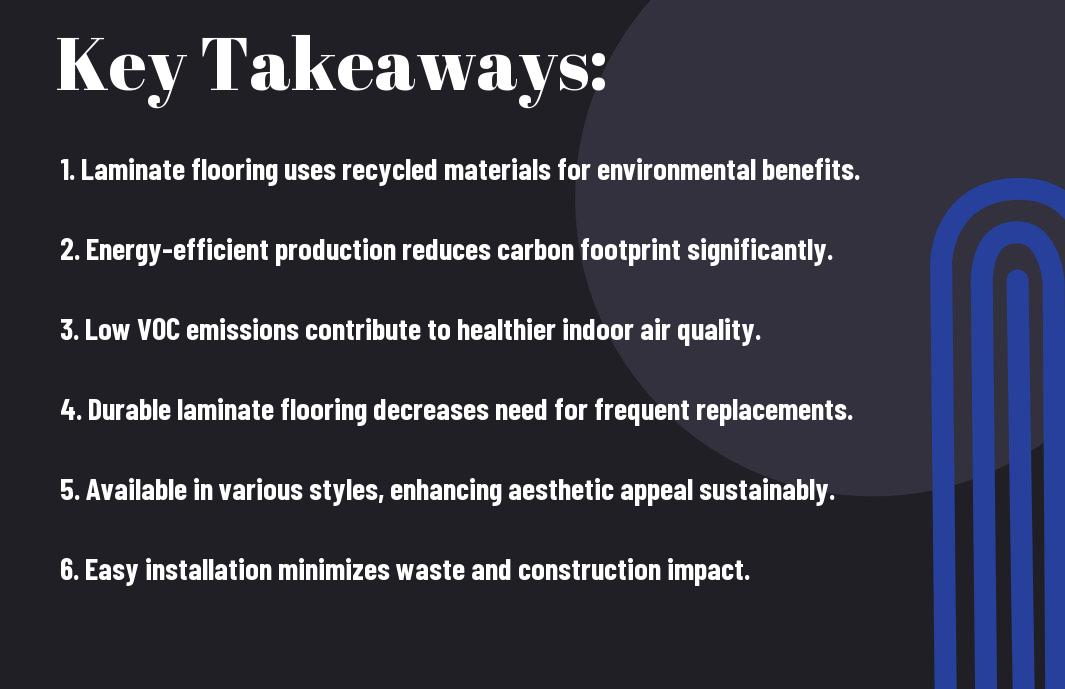With an increasing focus on eco-friendly living, choosing sustainable flooring is necessary for creating a healthier home and environment. Laminate flooring has emerged as a popular choice among homeowners looking to balance style, durability, and sustainability. By understanding the eco-friendly features of laminate, you can make informed decisions that align with your values while enhancing your living space. In this post, we’ll explore how laminate flooring fits into sustainable home choices and the benefits it offers for both you and the planet.

Understanding Sustainable Flooring
To choose the right flooring for your home, it’s crucial to understand sustainable flooring. This concept focuses on flooring options that minimize environmental impact through responsible sourcing, production processes, and end-of-life management. By opting for sustainable materials, you contribute to a healthier planet while enhancing the aesthetics and functionality of your living space.
Definition of Sustainable Flooring
One approach to sustainable flooring involves selecting materials that are renewable, recyclable, or made from reclaimed resources. This means you should consider flooring options that promote environmental stewardship and have a lower carbon footprint. Materials like bamboo, cork, and recycled options embody this commitment to sustainability.
Benefits of Eco-Friendly Materials
Definition of eco-friendly materials extends beyond just being good for the environment. By choosing sustainable flooring, you also benefit from improved indoor air quality, lower energy consumption, and enhanced durability. These materials often utilize fewer harmful chemicals in their production, ensuring a safer environment for you and your family.
The advantages of eco-friendly materials go beyond environmental benefits. When you invest in such flooring, you’re often choosing products designed to last longer, reducing the need for frequent replacements and conserving resources over time. Additionally, many eco-friendly options have unique aesthetics that can enhance the beauty of your space. By incorporating these materials, you take a significant step toward a more sustainable lifestyle, all while creating a welcoming and stylish home atmosphere.
Overview of Laminate Flooring
Clearly, laminate flooring has gained popularity as a versatile and affordable option for homeowners seeking stylish yet durable surfaces. Composed of multiple layers, it mimics the appearance of natural wood, stone, or tile but comes at a fraction of the price. As you explore your flooring options, you’ll find that laminate flooring is not only visually appealing but also suitable for various applications, from residential homes to commercial spaces.
Composition and Manufacturing Process
By understanding the composition and manufacturing process of laminate flooring, you can appreciate its eco-friendly aspects. Typically, laminate is made from high-density fiberboard (HDF), which is manufactured from recycled wood materials. The top layer consists of a high-resolution printed decor film, coated with a protective overlay, ensuring durability and longevity.
Advantages of Laminate Flooring
Manufacturing laminate flooring offers numerous advantages for you as a consumer, such as affordability, ease of installation, and a wide range of design choices. Its resilience against scratches and stains makes it a practical choice for busy households. Additionally, many varieties come with built-in moisture resistance, allowing for use in areas like kitchens and bathrooms.
But what truly sets laminate apart is its low environmental impact. The use of recycled wood materials in its production helps minimize waste, while its longevity reduces the need for frequent replacements. Laminate flooring is also easier to maintain compared to other flooring types, which means you can spend less time cleaning and more time enjoying your sustainably chosen home.

Environmental Impact of Laminate Flooring
Your choice of laminate flooring can significantly influence your home’s environmental footprint. While laminate may not be the purest eco-option, its design and manufacturing processes have evolved to reduce negative impacts. High-quality laminate floors are engineered with sustainability in mind, using recycled materials and less energy compared to traditional hardwood production, making them a smart choice for eco-conscious consumers.
Resource Efficiency
Across the board, laminate flooring stands out for its resource efficiency. It often utilizes a combination of composite materials and manufacturing processes that require fewer natural resources than solid wood. By opting for laminate, you are effectively choosing flooring that prioritizes sustainable sourcing and minimizes waste.
Lifecycle Analysis
Any comprehensive analysis of laminate flooring sustainability must consider its entire lifecycle. This includes aspects from raw material extraction to production, transportation, and eventual disposal or recycling.
Lifecycle assessments of laminate flooring reveal that, although the production phase can involve some environmental impact, the overall sustainability profile is positive. Laminates generally use recycled content, reducing the demand for virgin materials. Additionally, their longevity and ease of maintenance contribute to a lower overall ecological footprint, making laminate a responsible option for those looking to maintain an eco-friendly lifestyle.
Comparing Laminate to Other Flooring Options
After evaluating your flooring choices, it’s imperative to compare laminate to other popular options. Each type of flooring presents distinct advantages and disadvantages that can influence your decision based on your lifestyle and environmental priorities. The following table outlines these key differences:
| Flooring Type | Eco-Friendliness |
|---|---|
| Laminate | Moderate – made from recycled materials and has low VOC emissions. |
| Hardwood | High – sustainably sourced options available, but requires more resources to produce. |
| Vinyl | Low – petroleum-based, often contains harmful chemicals. |
Hardwood Flooring
Any homeowner who appreciates the authentic beauty of natural wood often considers hardwood flooring. While this option is highly durable and can increase the value of your home, the sustainability of hardwood depends on its sourcing. You need to ensure that you’re choosing certified products from responsibly managed forests to align with eco-friendly living practices.
Vinyl Flooring
Below traditional laminate, vinyl flooring is usually cheaper and simpler to install, but it comes with a downside regarding sustainability. Vinyl is made from PVC, a material that has significant environmental impacts during production and disposal.
Plus, vinyl flooring often contains additives that can emit harmful chemicals into your home over time. This not only affects indoor air quality but also raises concerns about the vinyl’s overall impact on the planet. If you’re seeking a sustainable solution, you should consider alternatives that are better for both your health and the environment.
Maintenance and Longevity
Many homeowners appreciate laminate flooring for its low maintenance and impressive longevity. With proper care, your laminate flooring can withstand the wear and tear of daily life while maintaining its aesthetic appeal. Regular cleaning and avoiding harsh chemicals can enhance its lifespan, making it an eco-friendly choice for sustainable living.
Care Tips for Laminate Flooring
About maintaining your laminate flooring, you can follow these care tips to keep it looking its best:
- Use a soft-bristle broom or vacuum for regular cleaning.
- Wipe up spills immediately to prevent moisture damage.
- Avoid excessive water; use a damp mop sparingly.
- Place mats at entryways to reduce dirt and debris.
Assume that consistent care will help extend the life of your laminate flooring.
Durability and Lifespan
Before choosing laminate flooring, it’s important to understand its durability and lifespan. Most laminate floors can last anywhere from 15 to 25 years, making them a solid investment for your home. They are resistant to scratches, dents, and stains, making them suitable for high-traffic areas, including homes with pets and children.
Further benefits of laminate flooring’s durability include its ability to withstand changes in humidity and temperature without warping. This resilience means you won’t have to worry about replacing your floor frequently, contributing to your eco-friendly lifestyle. Additionally, many brands offer warranties that reflect their confidence in the product’s longevity, giving you peace of mind as you enjoy your sustainable living space.
Making Informed Choices
Unlike traditional flooring options, laminate flooring provides an opportunity for you to select materials that align with your environmental values. By considering sustainability in your choice, you can enjoy the aesthetic and practical benefits of laminate while minimizing your ecological footprint. Researching the manufacturing processes and materials used will empower you to make educated decisions that contribute to eco-friendly living in your space.
Certifications and Eco-Labels
The importance of certifications and eco-labels cannot be overstated when selecting laminate flooring. These labels can help you identify products that meet specific environmental standards, ensuring that the materials are sourced sustainably and produced with minimal impact on the planet. By prioritizing certified options, you can trust in the quality and sustainability of your flooring choice.
Finding Responsible Suppliers
Making the effort to find responsible suppliers is a significant step toward an eco-friendly flooring decision. Look for companies that prioritize sustainable sourcing, use non-toxic adhesives, and have transparent supply chains. By doing your research, you can support brands that align with your eco-conscious values and help promote ethical practices in the flooring industry.
Finding responsible suppliers can enhance your flooring experience while supporting environmentally sustainable practices. Start by exploring local retailers and manufacturers that prioritize eco-friendly products, reading customer reviews, or seeking recommendations from trustworthy sources. Many reputable suppliers also share their sustainability initiatives on their websites or product packaging, making it easier for you to identify those that align with your values. Your choice to support these suppliers not only benefits your space but also contributes to a more sustainable flooring industry overall.
Final Words
On the whole, choosing laminate flooring can significantly contribute to your eco-friendly living efforts. By opting for this sustainable flooring option, you not only enhance the aesthetics of your space but also make a responsible choice for the environment. Laminate flooring is made from recycled materials, is durable, and can help you reduce your carbon footprint. As you consider your flooring choices, keep in mind how laminate can align with your commitment to a greener lifestyle while providing you with the style and functionality you desire.


